Wirst musculature anatomic variation associated with Guyon’s canal syndrome: a case report
DOI:
https://doi.org/10.34019/1982-8047.2021.v47.35457Keywords:
Guyon Syndrome, Ulnar Nerve Compression, Anatomic VariationAbstract
Introduction: Guyon's canal syndrome is the ulnar nerve compressive neuropathy at the level of the wrist, and one of its rarer etiologies is the presence of anomalous muscles crossing Guyon's canal. Objective: To report a case of a patient with Guyon's syndrome caused by the presence of accessory little finger abductor muscle. Case Report: The patient presented with a clinical presentation of paresthesia and pain in the 4th and 5th fingers of the right upper limb and positive Wartenberg and Egawa tests. After ultrassonography and eletroneuromyography, the presence of ulnar nerve compression at the wrist level (Guyon's syndrome) and also at the elbow level were demonstrated. During surgical treatment, anatomical variation of the acessory abductor little finger muscle was observed, which was anomalously crossing Guyon's canal, causing the compression of the ulnar nerve. After the procedure, the patient showed improvement in symptoms and progressed well with physical therapy. Conclusion: The presence of abnormal muscles can be the cause of compressive neuropathies. Through the case reported, it contributes to the dissemination of this knowledge about these anatomical variations, contributing to better management and treatment of the patients.
Downloads
References
Canale ST, Beaty JH. Campbell's Operative Orthopaedics. 12th. ed. New York: Elsevier; 2017.
Doherty TJ. Ulnar neuropathy at the elbow and wrist. In: Schefner JM, ed. UpToDate. Waltham, Mass.: UpToDate, 2021.
Uzel AP, Bulla A, Joye ML et al. Variation of the proximal insertion of the abductor digiti minimi muscle: correlation with Guyon’s canal syndrome? Case report and literature review. Morphologie. 2012; 96(313):44-50.
Bachoura A, Jacoby SM. Ulnar tunnel syndrome. Orthopedic Clinics of North America. 2012; 43(4):467-74.
Zeiss J, Jakab E, Khimji T et al. The ulnar tunnel at the wirst (Guyon’s Canal): normal MR anatomy and variants. American Journal of Roentgenology. 1992; 158:1081-5.
Harvie P, Patel N, Ostlere SJ. Prevalence and epidemiological variation of anomalous muscles at guyon's canal. J Hand Surg Br. 2004; 29(1):26-9.
Madhavi C, Holla SJ. Anomalous flexor digiti minimi brevis in Guyon's canal. Clinical Anatomy. 2003; 16(4):340-3.
Ramavath AL; Sakamuri R. Guyons canal syndrome due to accessory palmaris longus muscle: aetiological classification: a case report. Cases Journal. 2009; 9146.
Paraskevas GK, Ioannidis O, Economou DS. Anomalous muscle causing ulnar nerve compression at Guyon's canal. Journal of Plastic Surgery and Hand Surgery. 2012; 46(3-4):288-90.
Earp BE, Floyd WE, Louie D et al. Ulnar nerve entrapment at the wrist. Journal of American Academy of Orthopedic Surgery. 2014; 22(11):699-706.
Duarte ML, Santos LR, Cuzziol E et al. Músculo abdutor do dedo mínimo acessório causando a síndrome do túnel ulnar: diagnóstico ultrassonográfico. Jornal de Ciências e Saúde. 2018; 1(3):61-4.
Leite NM, Albertoni WM, Leite VM. Compressão isolada do ramo profundo do nervo ulnar por variação da anatomia. Revista Brasileira de Ortopedia. 1993; 28(7).
Coraci D, Loreti C, Piccinini G et al. Ulnar neuropathy at wrist: entrapment at a very "congested" site. Neurology Science. 2018; 39(8):1325-31.
Lleva JMC, Munakomi S, Chang KV. Ulnar Neuropathy. In: StatPearls. Treasure Island: StatPearls Publishing; 2020.
Ardouin L, Lecoq FA, Le Nen D et al. An ultrasound diagnostic aid in hand surgery: observation on a supernumerary muscle in the wrist. Chirurgie de la Main. 2014; 33(6):401-3.
Downloads
Published
How to Cite
Issue
Section
License
Copyright (c) 2021 Arnaldo Gonçalves de Jesus Filho, Gabriel Meireles Azevedo Pereira, Marcos Vitor Pires Duque, Arthur Chaves de Almeida, Ana Júlia Machado Talma

This work is licensed under a Creative Commons Attribution 4.0 International License.
Cessão de Primeira Publicação à HU Revista
Os autores mantém todos os direitos autorais sobre a publicação, sem restrições, e concedem à HU Revista o direito de primeira publicação, com o trabalho licenciado sob a Licença Creative Commons Attribution que permite o compartilhamento irrestrito do trabalho, com reconhecimento da autoria e crédito pela citação de publicação inicial nesta revista, referenciando inclusive seu DOI.









